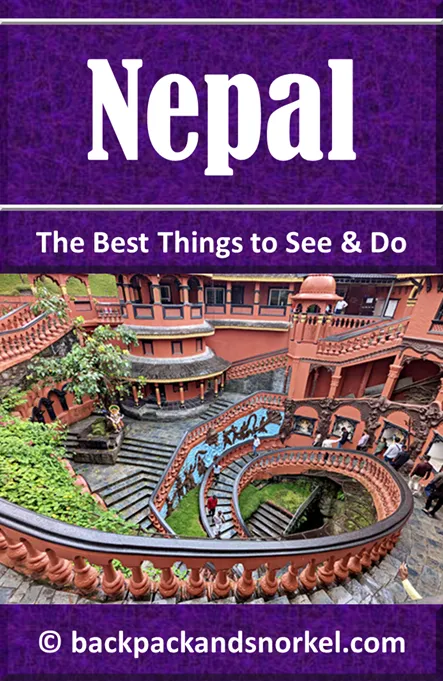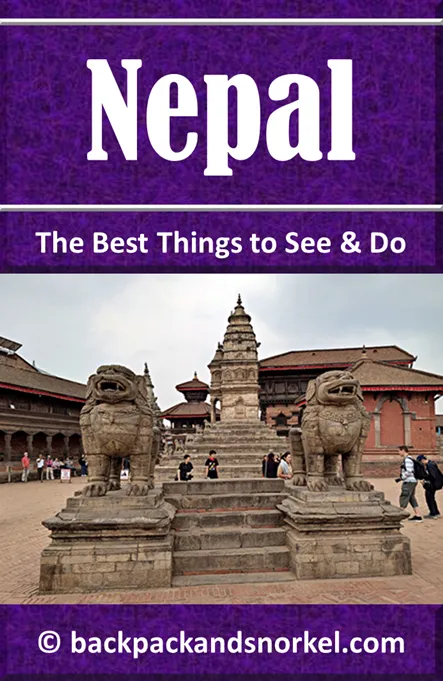Unlock Patan Durbar Square: Your Ultimate Self-Guided Walking Tour - Nepal Purple Travel Guide
(map, reviews)
This is Premium Content! To access it, please download our
Backpack and Snorkel Purple Travel GuidePatan Durbar Square is the smallest of the three Durbar Squares, and it is often considered to be the most beautiful one. It is famous for its harmonious blend of Hindu and Buddhist monuments, intricately carved temples, and historical courtyards (bahals).
Patan Durbar Square is one of the seven monument zones that together make up the ‘Kathmandu Valley’ UNESCO World Heritage Site, which was inscribed in 1979.
The seven monument zones are:
Kathmandu Durbar Square
Patan Durbar Square
Bhaktapur Durbar Square
Swayambhunath Stupa
Boudhanath Stupa
Pashupatinath Temple
Changu Narayan Temple
The word ‘Durbar’ means ‘palace’ in Nepali, and Patan Durbar Square was once the royal palace complex of the Malla kings of Lalitpur. ‘Patan’ itself is the Sanskritized form of ‘Lalitpur’, meaning City of Beauty.
The square was the seat of power for the Malla dynasty from the 14th to the 18th centuries and served not only as a political hub but also as a center of art, learning, and religion.
Here at Backpack and Snorkel Travel Guides, we typically promote self-guided walking tours.
But we realize that not everybody likes to walk by themselves in a foreign city. So, just in case that you rather go with ab guide: NO PROBLEM! Please see the Viator tours below.
free GuruWalk tours
paid Viator tours
Self-Guided Walking Tour of Patan Durbar Square
If you have followed our Patan walking tour, then you will enter Patan Durbar Square from the north.
Please be advised, that foreigners must pay an admission of Rs1000 per person at the payment booths – Nepali citizens can enter for free. There are no barriers that restrict you from entering, but if you don’t pay, then it will only be a matter of time that a guard will find you, and ask you to go to the payment booth and pay.
We have not seen any payment booths in the north. There is a payment booth in the south near Chyasin Dewal (point P on the map). We did our self-guided walking tour through the square, and paid when we got towards the end, as we wanted to enter Mul Chowk (point L on the map), and the guards at Mil Chowk checks if you have bought the general admission ticket.
Chances are that, if you come from the north and don’t pay, a guard will approach you – just tell them that you cam e from the northern entrance and there was no ticket seller. Then you go and pay.
Patan Durbar Square is open 24/7, and admission is typically collected from 9am – 6pm.
Some of the buildings are open to visitors. Their opening times vary, but they are typically open from 9am – 6pm.
The following map shows the points of interest in Patan Durbar Square:

Bhimsen Mandir
(map, reviews)
This is Premium Content! To access it, please download our
Backpack and Snorkel Purple Travel GuideThe temple was originally built in 1680 during the reign of King Srinivasa Malla, one of Patan's most prominent Malla kings. It stands out with its three-tiered pagoda design, intricately carved wooden struts, and beautifully detailed windows, a hallmark of classic Newar architecture.
The image of Bhimsen inside the temple is not open to tourists, but the temple's exterior and surrounding activity offer rich insight into its cultural importance.
Detailed information can be found at our Bhimsen Mandir Page
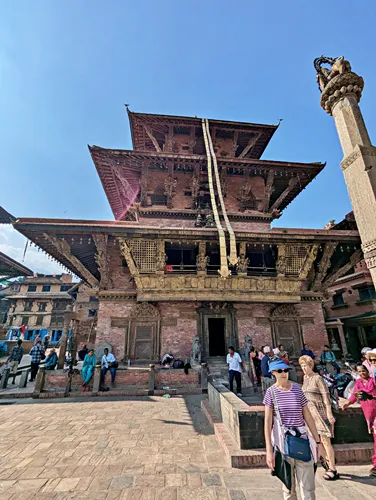
Vishwanath Temple
(map, reviews)
This is Premium Content! To access it, please download our
Backpack and Snorkel Purple Travel GuideThe Vishwanath Temple in Patan was commissioned during the reign of King Siddhi Narsingh Malla in 1627, a period marked by great artistic and architectural achievements in the region. Built in the classic Newar pagoda style, the temple features two tiered roofs, finely carved wooden struts, and intricate metalwork adorning its doors and windows.
A pair of stone elephants guards the entrance, a typical feature of important temples, symbolizing strength and protection. The temple’s exterior showcases detailed depictions of Shiva, including scenes of him in meditation and as Nataraja, the cosmic dancer.
Detailed information can be found at our Vishwanath Temple Page
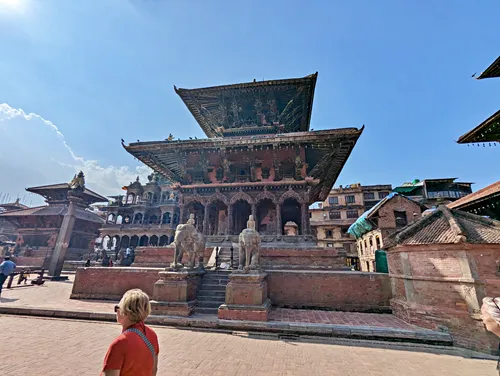
Manimandap
(map, reviews)
This is Premium Content! To access it, please download our
Backpack and Snorkel Purple Travel GuideAcross the street from Vishwanath Temple, to the east, there are two identical pavilions known as Mani mandapa or Jewel Pavilion.
These structures are believed to have been constructed during the reign of King Yoganarendra Malla, with inscriptions dating their origin to around 1758.
In ancient times, mandapas like these were used for royal coronations, public audiences, and religious ceremonies, serving as open pavilions where kings and priests could engage with the people during major events.
Detailed information can be found at our Manimandap Page

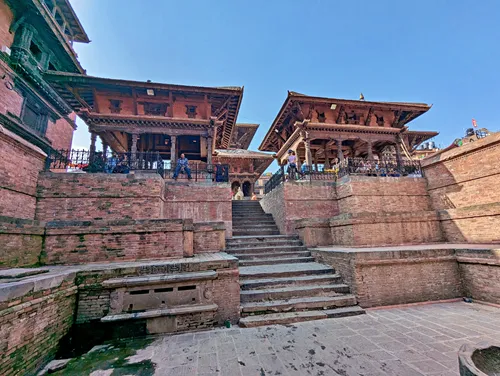
Manga Hiti
(map, reviews)
This is Premium Content! To access it, please download our
Backpack and Snorkel Purple Travel GuideManga Hiti is one of the oldest and most beautifully preserved stone water spouts (hiti) in the Kathmandu Valley. More than just a practical source of water, this historic fountain reflects centuries of Newar engineering, artistry, and urban planning.
Detailed information can be found at our Manga Hiti Page
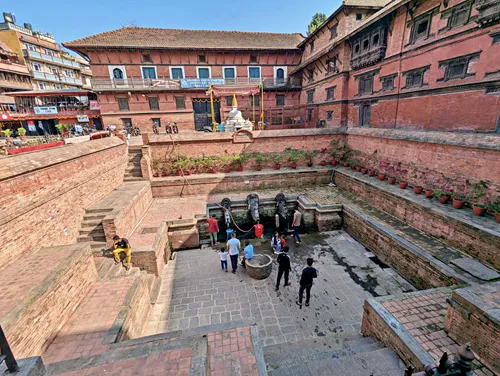
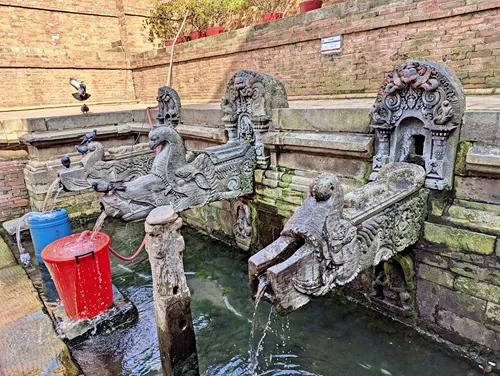
Mani Chaitya
(map, reviews)
This is Premium Content! To access it, please download our
Backpack and Snorkel Purple Travel GuideRight behind Manga Hiti you can see a white mini stupa, a chaitya.
The Mani Chaitya is a Buddhist stupa that houses four golden prayer wheels (known as mani wheels).
Detailed information can be found at our Mani Chaitya Page

Krishna Mandir
(map, reviews)
This is Premium Content! To access it, please download our
Backpack and Snorkel Purple Travel GuideAmong the many historic temples in Patan Durbar Square, Krishna Mandir stands out for its unique architecture, intricate carvings, and deep religious significance. Built entirely from stone in the early 17th century, it remains one of the finest examples of Shikhara-style temple architecture in Nepal — a rarity in a valley otherwise dominated by tiered pagoda structures.
Detailed information can be found at our Krishna Mandir Page
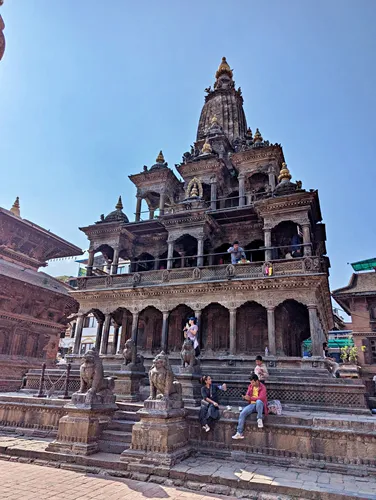

Patan Museum
(map, reviews)
This is Premium Content! To access it, please download our
Backpack and Snorkel Purple Travel GuidePatan Museum is a cultural gem that brings Nepal’s rich artistic, religious, and architectural heritage vividly to life. Housed in a beautifully restored former royal palace of the Malla kings, the museum is a must-visit for travelers interested in Hindu and Buddhist art, traditional craftsmanship, and the history of the Kathmandu Valley.
Detailed information can be found at our Patan Museum Page


Char Narayan Temple
(map, reviews)
This is Premium Content! To access it, please download our
Backpack and Snorkel Purple Travel GuideChar Narayan Temple is also known locally as Pyamha Narandya. It is one of the oldest temples in Patan Durbar Square, and a beautiful example of traditional Newar pagoda architecture.
Detailed information can be found at our Char Narayan Temple Page


King Siddhi Narsingh Malla Statue
(map, reviews)
This is Premium Content! To access it, please download our
Backpack and Snorkel Purple Travel GuideThe statue of King Siddhi Narsingh Malla stands as a tribute to one of the city's most influential rulers. A key figure during the golden age of the Malla dynasty, Siddhi Narsingh Malla reigned from 1619 to 1661, leaving behind a legacy of extraordinary art, architecture, and spiritual patronage.
Detailed information can be found at our King Siddhi Narsingh Malla Statue Page


King Yognarendra Malla Statue
(map, reviews)
This is Premium Content! To access it, please download our
Backpack and Snorkel Purple Travel GuideRising gracefully on a tall stone column in the heart of Patan Durbar Square, the statue of King Yog Narendra Malla is one of the most iconic monuments in the Square. This elegant bronze figure, crafted in the early 18th century, honors a beloved Malla king whose reign (1684–1705) marked a period of cultural and architectural brilliance in Patan.
Detailed information can be found at our King Yognarendra Malla Statue Page
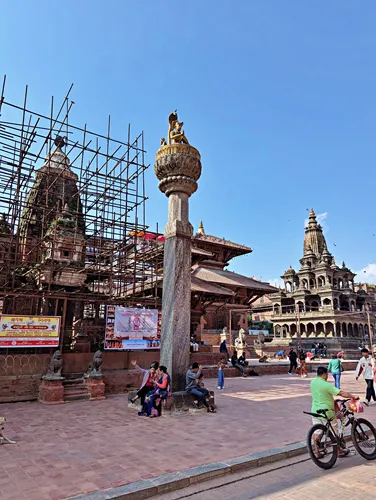
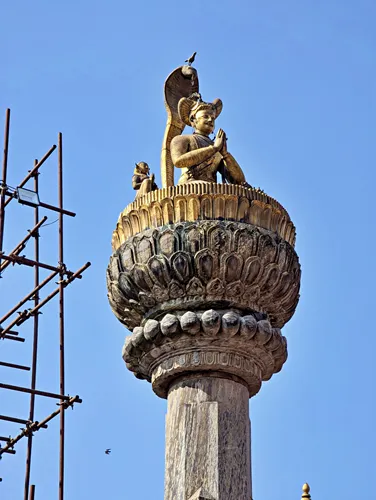
Taleju Bell
(map, reviews)
This is Premium Content! To access it, please download our
Backpack and Snorkel Purple Travel GuideTaleju Bell is a large ceremonial bell which served an important civic purpose during the rule of the Malla kings and stands today as a symbol of the intersection between faith and governance in traditional Nepalese society.
Detailed information can be found at our Taleju Bell Page

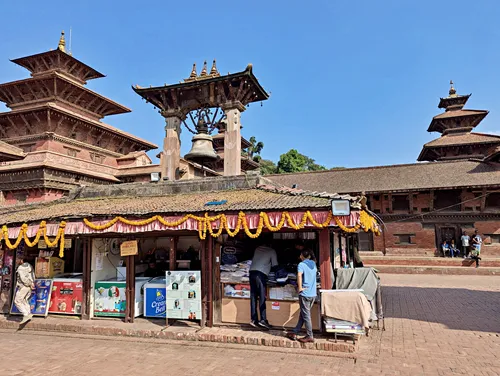
Mul Chowk
(map, reviews)
This is Premium Content! To access it, please download our
Backpack and Snorkel Purple Travel GuidePatan Durbar Square, Mul Chowk is the largest and most important courtyard in the former Royal Malla Palace.
Mul Chowk was constructed during the Malla period, most likely in the 17th century. While an exact construction date is not definitively recorded, historical and architectural evidence suggests that King Siddhi Narsingh Malla (reigned 1619–1661) was instrumental in its development.
Detailed information can be found at our Mul Chowk Page
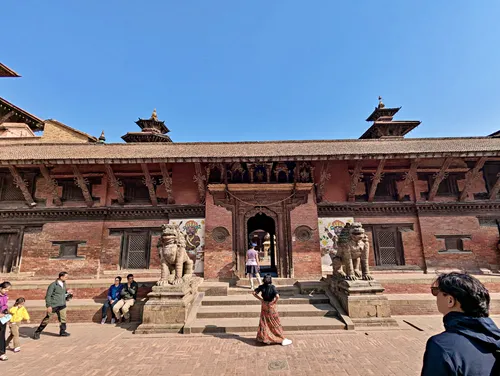
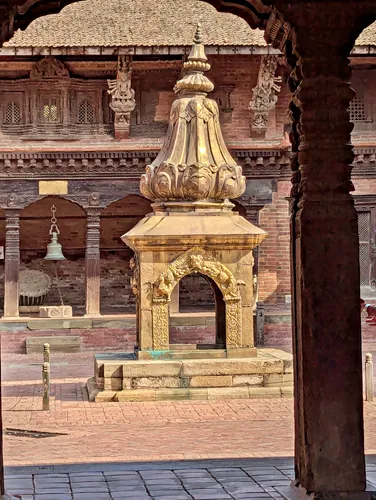
Ganesha Statue
(map, reviews)
This is Premium Content! To access it, please download our
Backpack and Snorkel Purple Travel GuideGanesha Statue - A Sacred Symbol of Wisdom and Protection Dedicated to Lord Ganesha, the elephant-headed deity of wisdom, beginnings, and protection, this statue holds cultural and spiritual significance for Hindu devotees in the Kathmandu Valley.
This statue is part of a trio of deities: Ganesh, and nearby: Narasimha, and Hanuman.
Detailed information can be found at our Ganesha Statue Page

Statues of Narsingha and Hanuman
(map, reviews)
This is Premium Content! To access it, please download our
Backpack and Snorkel Purple Travel GuideThe statues of Narsingha and Hanuman stand side-by-side in Patan Durbar Square as powerful symbols of divine strength, protection, and devotion. These two revered Hindu figures, one a fierce avatar of Vishnu, the other the devoted servant of Rama, are placed in front of the Royal palace, underscoring their historic and religious importance.
Detailed information can be found at our Statues of Narsingha and Hanuman Page

Maharani Hiti
(map, reviews)
This is Premium Content! To access it, please download our
Backpack and Snorkel Purple Travel GuideWith its blue painted walls, Maharani Hiti looks like an ordinary pond that may have been installed in the last 50 years. But in reality it is a much more historically rich attraction, dating back to the Malla period.
The design of Maharani Hiti is quite different from the traditional stone water spouts you have seen so far, suggesting that it has been altered over time. While it still features a beautifully decorated outer stone wall, the inner walls are now painted blue, and the basin is relatively shallow - more like a pool than a typical hiti.
Detailed information can be found at our Maharani Hiti Page
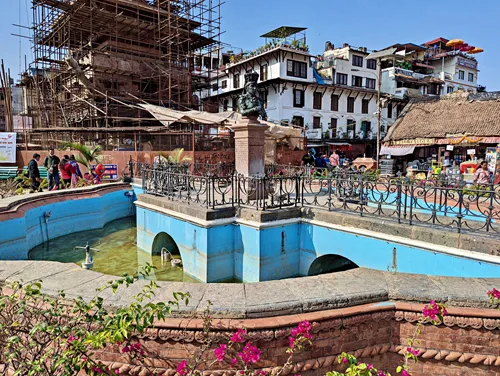
Chyasin Dewal
(map, reviews)
This is Premium Content! To access it, please download our
Backpack and Snorkel Purple Travel GuideWith its unique octagonal shape and white dome, Chyasin Dewal offers a beautiful contrast to the red brick and dark wood architecture that surrounds it.
This elegant structure is dedicated to Lord Krishna, a beloved deity in Hinduism known for his roles as a divine lover, mischievous child, and wise charioteer in the Mahabharata.
Chyasin Dewal was built between 1637 and 1647 during the reign of King Siddhi Narsingh Malla, a prominent Malla king of Patan known for his contributions to art, architecture, and religious monuments.
Detailed information can be found at our Chyasin Dewal Page
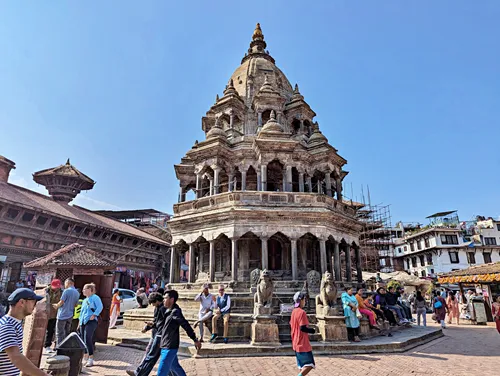
Back to your Day 3 in Nepal Itinerary
Author: Rudy at Backpack and Snorkel
Bio: Owner of Backpack and Snorkel Travel Guides. We create in-depth guides to help you plan unforgettable vacations around the world.
Other popular Purple Travel Guides you may be interested in:
Like this Backpack and Snorkel Purple Travel Guide? Pin these for later:

